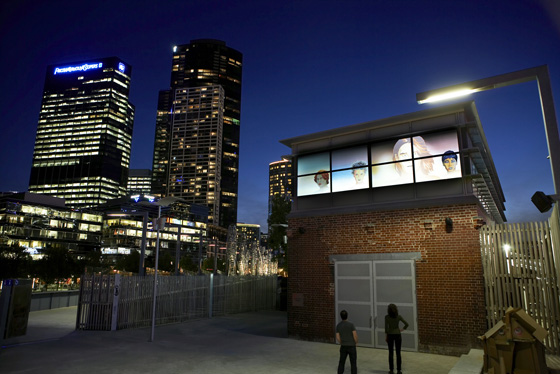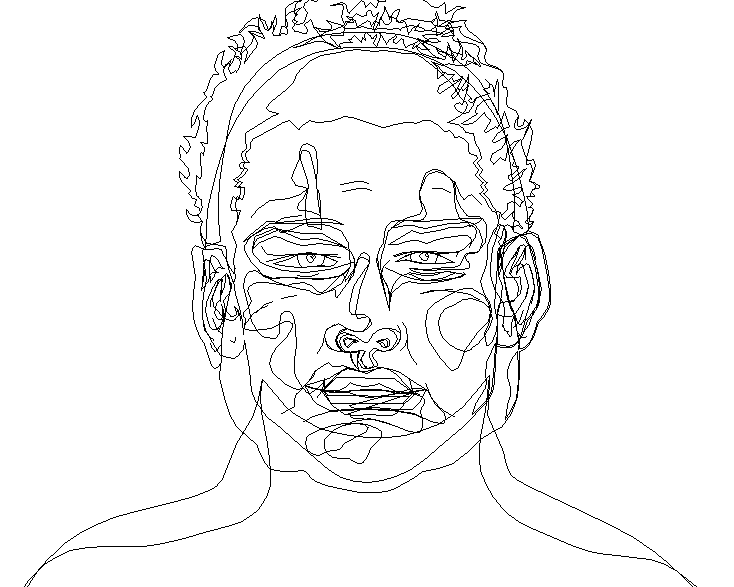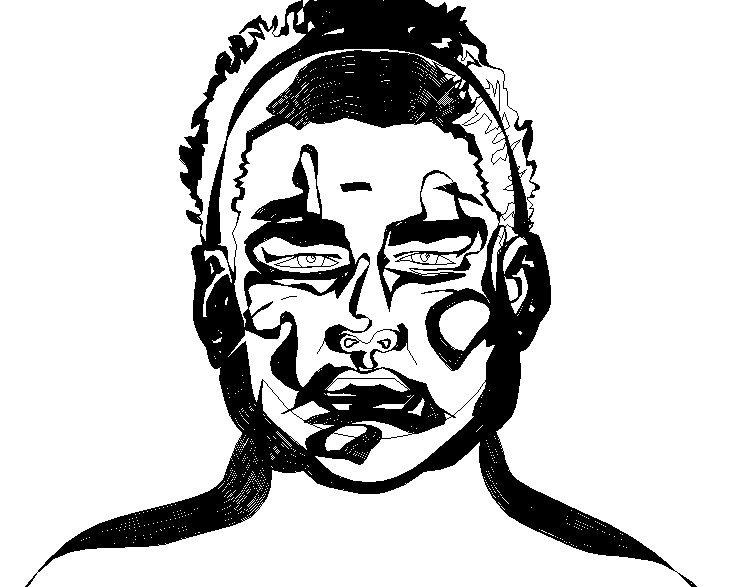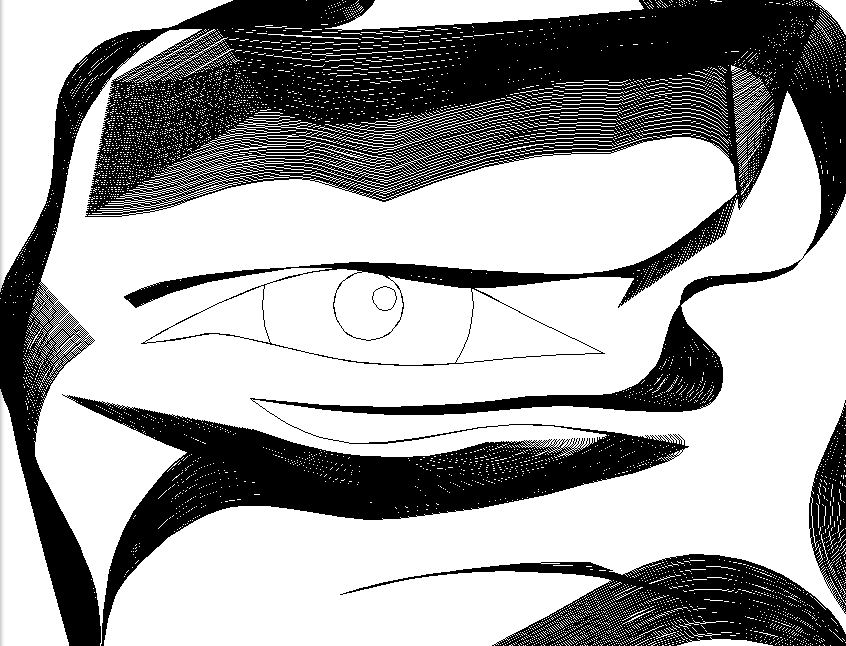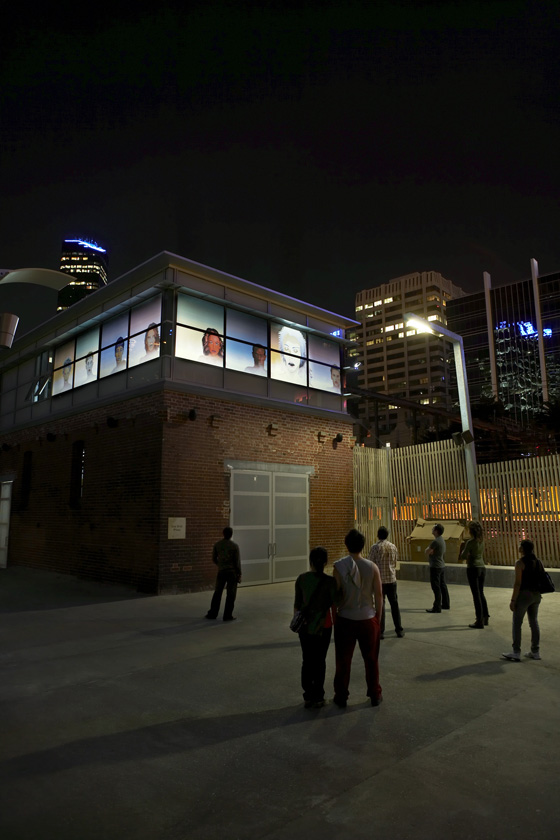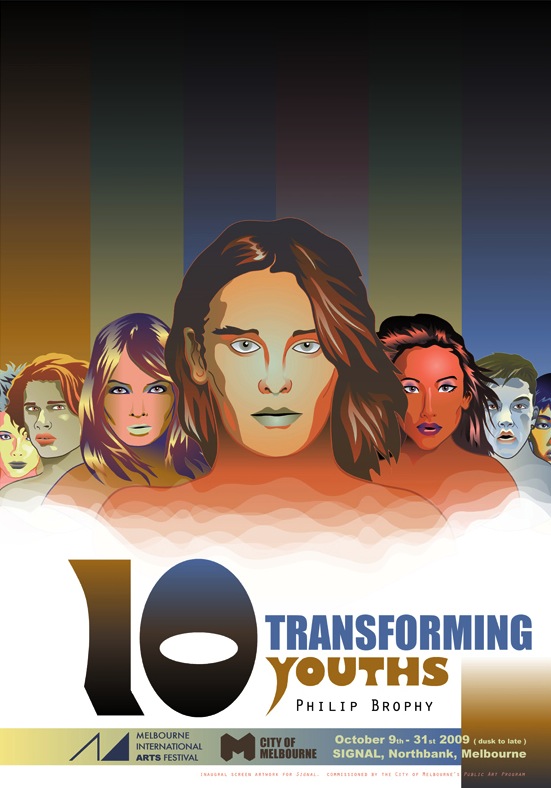Background
10 Transforming Youths is a 4-screen digital animation with quadraphonic sound. This work has been commissioned by the Melbourne City Council's Public Art Program as the inaugural artwork to be projected from dusk to 3am at the new Signal building site - a Youth Arts facility on Northbank overlooking the Yarra River in the city centre of Melbourne.
Rendered in a graphic hard-edged Pop style, a line of 10 youths (framed as heads and torsos) stare blankly at the viewer. Though standing still, they move continually as if on an invisible conveyor belt. They are set against a wash of dark colours, like a brooding eternal dusk. Their bodies are framed centre; their lower torsos disappearing into a luminous fog. Their faces and features are clearly visible as they move left-to-right slowly across the 4 linked projector screens. Moving in the counter direction, one youth at a time enters, then pauses framed in close-up. His/her head occupies the full height of the screens. Sometimes with eyes shut and sometimes staring straight ahead to the viewer, he/she gradually ages. Sometimes, subtly – as if time has not affected him/her too much. Other times, the aging seems accelerated to 50 years. But after each time he/she ages, he/she returns to their youthful state, and exits toward the direction they were heading. Occasionally and randomly, his/her face will move forward in extreme close-up. The spatial shifts grant the viewer differing perspectives on the changing metamorphosis of each depicted youth.
The concept of transformation relates to Brophy's ongoing interest in animation's 'in-between' flux of identity (as in the 2-screen digital animation Vox from 2007). 10 Transforming Youths is not an attack on its subject matter, but an embrace of the uncomfortable schisms acted out by the young people depicted. Their 'inbetween' state is not simply framed by opposing 'young' to 'old', but rather by how the young imagine themselves aged and how the aged imagine themselves young. Neither provides a stable sense of identity, and 10 Transforming Youths depicts this powerful purgatory for the terminally young.
Signal, Melbourne 2009 © 2009 - photo by Lynton CrabbCredits
Concept & direction - Philip Brophy
Design & key animation - Philip Brophy
Inbetweening - Steven Whatmough, Idora Alhabashi, Isobel Knowles, Teishan Ahearne
Source video filming - Philip Brophy
After Effects post-production & scripting - Steven Whatmough
Technical advice - Sam Page, Tom Dawe
Score - Philip Brophy
Vocalists - James Cecil, Lachlan Franklin, Gus Franklin, Adam Green, Isobel Knowles, Sianna Lee, Phip Murray, Que Nguyen, Thembi Soddell, Shannon Smiley
Score production & 5-channel mix: Philip Brophy
Production assistance - Sam Page
Thanks - Andrea Kleist, Laura Ogden, Karra Rees, Simon Maidment, Byron Scullin
2010
Signal, Melbourne (extended run)
Catalogue with DVD - published by City of Melbourne
2009
Signal, Melbourne (as part of the Melbourne International Arts Festival)
4-screen composite still © 2009Overview
10 Transforming Youths addresses the City of Melbourne commission's remit to deal with aspects of 'youth culture' in some way. The work chooses not to add another skateboarding/MP3/mobile phantasm of youth consumerism to the mediascape of public imagery, but instead tackle the state of a mediascape already saturated with youth imagery. The result is a work that depicts youth as nodes in a network of desire invented and maintained by mass marketers and product branders - many of who might be parents who neurotically want to appear 'hip' by living out regressive fantasies of 'staying young' and inflicting such imagery upon young people. While young people may look at such imagery (for alcohol, technology, fashion lifestyle and leisure pursuits) and identify 'themselves' within its mirages, one wonders what kind of 'mirror' stands in front of their gaze. 10 Transforming Youths provides an inverse mirror, wherein one can see the temporal viscitudes of aging, of living, of being.
In 10 Transforming Youths, the parade of impassive countenances, stabilized by a cyclic flux of time and momentum, paints a revolving panorama of how age transforms the Self. The calm of the youths as they age and rejuvenate creates a phantasmal experience for the viewer to consider their past and future, irrespective of their own age. ‘Youth’ is thus presented as a locus for contemplative dynamism. The transformative act of on-screen aging affords a wide range of viewers a liberating ‘out-of-body’ experience, inviting one to fantasize the impact of age upon oneself.
The intention is to create an inclusive experience in direct contrast to the divisive ‘age-demographic’ marketing which assails us from both conservative commercial and progressive community enterprises. The ‘public image of youth’ as projected throughout the mediascape is a constant static signifier, designed to target and ensnare those who register themselves in its mirror mirage. (‘Senior Citizens’ lifestyle marketing and ‘New Family Home-Owners’ real estate hawking work in similar fashion.) Youth imagery has become a particularly narrow option as technological fetishization targets them via expensive marketing. 10 Transforming Youths wishes to change the static icon of ‘Youthdom’ into a site of possibility and potentiality. In short, it seeks to transform the media mirror into a broader dimension of identity – to allow all ages to consider the spectrum of age.
4-screen composite still © 2009Technical
Image
Hovering somewhere between airbrushed sterility, wall-stenciled sharpness and manga-styled appearance, the look of 10 Transforming Youths's faces employs Pop-effects to iconicise the individual portraits which comprise the animation. The faces of the 5 boys and 5 girls exude a calmly disquieting passivity. No action or even desire is suggested by their faces: indeed, their 'emptiness' is exactly what youth marketers/branders would most like youth to be. In this sense, their sullen lack of presence is perfectly achieved via the graphic flatness of their chiselled features.
While the faces are distinct from each other - replete with racial suggestions in their visage and physiognomy - their pupils are completely identical in size. Their placement within the panorama frame is also fixed, aligning their movement with robotic precision. Like mannequins of ideal youth, they sail through life and space with neither reaction nor response to the void of their surroundings.
But aside from these conceptual concerns, the bulk of the animation has centres on the emotional tonality of each youth. Each youth I now regard as an individual character. Some of them physically age by gaining weight and appearing puffy; others oppositely become thin and withered. Some of them will appear anxious in their transformed state; others will appear comfortable – jolly, even. 10 Transforming Youths proposes the notion of ‘aging’ as something to be interpreted not simply in years, but in the effect of having lived life. Some of the animation’s characters thus appear to have lived hard, leaving their transformation to evidence degrees of either physical or psychological wear. Others appear to have lived a happy life, carrying their age with grace, comfort and wisdom. These aspects of the youths’ characterization is subtle, but it has been an important facet in determining the individual approaches to transformation with each youth. Ultimately, it is the nuance of transformation in each individual youth that the work aims to impart to an audience. While the work has a high-impact visual appeal due to its adopted visualization, the audience’s contemplation of the youths’ transformation is envisaged as the optimal experience.
Signal, Melbourne 2009 © 2009 - photo by Lynton CrabbAnimation
10 Transforming Youths employs a technique of animation and compositing originally developed in works like The Body Malleable and Vox. Hand drawn images are converted into vector images (using Freehand) which are then animated (also using Freehand). The resulting look is highly-graphic, and the movement is deliberately unnatural. This is in opposition to the mania for highly realistic 3D-CGI animation typical of blockbuster children’s entertainment. 10 Transforming Youths eschews such mainstream operations for overtly Pop graphic sensibilities.
More importantly, the meld of hard-edged 'super-flat' graphics with computer generated motion and morphing generates a conscious collapse between pseudo-realistic effect (the smoothness of movement generated by CG mathematically-correct motion simulation and depth) the reality of the non-photographic 'pseudo-ness' (the 'superflatness' of the image that in no way attempts to convince the viewer that it is 'real'). While this conundrum has been exploited to highlight sexual and bodily titillation and repulsion in The Body Malleable and Vox. here such an effect offers to the viewer an unscientific yet palpable projection of aging upon the body. The youths' faces do not age according to correct physiological dynamics of change, but rather they literally morph between 2 semiotic states - the state of 'being young' and the state of 'being old'.
To achieve and maintain this precise effect, the drafting and design of the youths' faces were broken down in the 2 key states. Careful vector alignment between these forms then enabled a highly detailed blending between those key frame, which in turn generates the final effect of 'pseudo-aging' and 'pseudo-rejuvenation'.
Vector details - production stills © 2009The final animation runs for 32 minutes and covers a matrix of possibilities for each face to age or not age, to open its mouth or not, and at 6 different points across the panorama field of the 4 screens. The luminous fog 'landscape' and all the individual veins, swirls wafts and trails of luminous fog were produced from filming black ink in water, then reversing the footage and layering it up in After Effects. All the final sequencing, compositing and layering of all elements was also done in After Effects. The animation's dimensions across the 4 screens is a custom hyper-widescreen of 4096 pixels wide by 502 pixels high.
After Effects was also crucial in rendering everything at a frame rate of 100 frames per second instead of the standard 25 frames per second. This was to enact as smooth as possibly a left-to-right movement and eliminate any strobing effects. A final rendered Quicktime movie is presented in looping mode on site.
Installation
The design of 10 Transforming Youths is specifically built around not only the 4-screens of the Signal Box, but also the Mondrian-like grid break-up of the 4-screens. This grid format is evident elsewhere in the architectural design of the Signal Box. Thus each of the 4-screens of this work is split into two horizontally (with two distinct hues per screen) and three vertically (via a set of graduating tones from top to bottom). The colour palette is also one derived from the old brickwork: the resulting work eschews bright candy colours for a series of muted yet deep tones.
The movement of the youths from left-to-right also highlights the corner axis of the building. The movement is a key device in both inviting the viewer to consider the ¾ angle, and creating a full experience of the configuration of 4 screens across 2 walls.
The timing of the youths’ movements across the screens – and of the rate of their transformations – is based on time-frames of experiencing the work in-situ. While brevity and precision in timing are crucial to effectively enabling the work to function in a public space, the work’s timings are modulated by variance in the rate, amount and position of each youth’s transformation. The standard timing of each transformation is around 8 seconds. This is fast enough to catch one’s eye in a visually cluttered environment such as Northbank (facing due west toward that corner of the city’s skyscrapers) yet slow enough to suggest a graceful, grounded and elegant floating momentum as each youth is carried across the 4-screens.
Signal, Melbourne 2009 © 2009 - photo by Lynton Crabb





